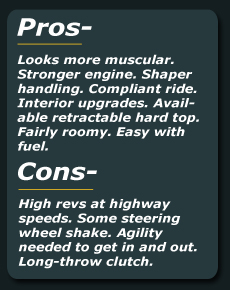2009 Mazda Mazda MX-5 Miata
Prices: $21,750-$29,290
The Mazda MX-5--better known as the Miata--arrived in 1989 as a 1990
model and convinced automakers, who had virtually given up on
affordable two-seaters, that a well-designed two-seat sports car would
be embraced by the public.
In fact, the Miata has become the world's top-selling two-seat
roadster, with nearly 900,000 sold throughout the world. The car was
conceived mainly for the U.S. market, and America always has been the
car's biggest market.
The first Miata had a 1.6-liter four-cylinder engine and only cost
$13,800. It was inspired by 1960s British sports cars, such as the
Lotus Elan. Even the original Miata was tuned to mimic the sound of
dual-carbureted sports cars of the 1960s.
The Miata has been constantly improved through the years, although its
bulky flip-up headlight covers are long gone, and the 2009 model has an
impressive bunch of updates.
Fairly light and well balanced, the rear-wheel-drive Miata has always
been a kick to drive, and suspension changes have made it even more so
for 2009.
The Miata comes with an easily lowerd soft top or retractable hard top.
Soft-top Miatas start with the entry $21,750 SV and move to the Sport,
Touring and $27,450 Grand Touring.
The SV is closest to the low-frills, low-price car the Miata once was,
but still comes with a five-speed manual transmission, AM/FM/CD player
with six speakers, side air bags, 16-inch aluminum wheels and power
windows and mirrors.
The Sport adds air conditioning, and the Touring gets remote keyless
entry, cruise control and steering-wheel-mounted cruise/audio controls
and an in-dash 6-disc CD changer. The manual gearbox is replaced with a
six-speed manual and wheels are upgraded to 17-inch alloys.
The top-line Grand Touring gets heated leather seats, automatic climate
control and faux leather door trim, besides a Bose sound system with
seven speakers.
A $1,650 Premium Package for the Grand Touring contains a stability
control system with traction control, hands-free phone and and Sirius
satellite radio.
My test car had that package and a $500 suspension package with a sport
tuned suspension, Bilstein shock absorbers and a limited-slip
differential.
Retractable hardtop versions skip the SV and begin with the $25,390
Sport and end with the $29,290 Grand Touring. I tested a $28,190 Grand
Touring version with the retractable hard top and manual transmission.
Introduced for 2007, the retractable top provides all-weather
flexibility and added security. Its opening and closing cycles takes
only 12 seconds. A driver just releases a latch and pushes a button to
lower it. It's said to be the fastest power-operated retractable hard
top. And it's the only such top on the market that doesn't steal trunk
space because it splits in two and tumbles into the cavity behind the
seats.
The hard top looks stubbier than the soft top, but is attractive when
raised and doesn't add a lot of weight.
The decently shaped trunk is fairly roomy, at least for a small
two-seater.
Improvements include a stouter, more lively 2-liter four-cylinder
engine. Horsepower is only up to 167 from 166, but that hardly tells
the story. The redline of the engine, which has chain-driven dual
overhead camshafts and 16-valves, has been increased 500 rpm to 7,200
rpm (on manual-transmission models)--thanks to a forged steel
crankshaft and connecting rods, stronger pistons, stiffer valve springs
and an oil cooler.
A new "Induction Sound Enhancer" on six-speed manual-transmission
models provides "pleasing engine sounds."
There are a five- and six-speed manual transmissions and a six-speed
automatic with steering-wheel paddle shifters. My test MX-5 had the
manual gearbox, which has been revised to provide quicker, lighter,
more direct shift feel.
However, it still takes a firm hand to shift. The clutch has a long
throw, but light action and progressive take-up to prevent jerky starts.
The six-speed manual transmission's sixth gear is a little "taller"
(787:1 versus 832.1) for better fuel economy and more relaxed highway
cruising. Still, the engine is turning over at a fairly busy 3,000 rpm
at 65 mph and at 3,250 rpm at 70. But it doesn't feel strained and is
generally quiet.
A downshift to fifth or fourth gear is needed with the manual for good
65-75 mph passing times. Don't want to shift? Well, the automatic works
pretty well, but seems out of place in such a basically retro-style
sports car.
Fuel economy? Figure are about 22 in the city and 27 on highways with
the five-speed manual, 21 and 28 with the six-speed manual and 20 and
27 with the automatic. Premium fuel is recommended.
The more aerodynamic 2009 MX-5 looks more muscular, with a new, more
aggressive front fascia featuring a new grille and a new headlight
design. There also are new side sills, a revised rear bumper design,
new rear combination lights with a more aerodynamic shape and new
lightweight 16- and 17-inch wheels.
New colors include Competition Yellow and Liquid Silver Metallic.
There's also a new soft top color.
The MX-5's fairly roomy interior is especially quiet with the hard top
up and remains businesslike, although this is one of those low "drop-
in/climb-out" cars. It has easily read gauges and conveniently placed
controls. There's still a fair amount of hard plastic, but the upgraded
cockpit has new materials for a higher-quality feel and changes are
focused on areas the driver mainly touches.
For instance, the shape of the nicely supportive seats has been refined
for better lower-body comfort, and the center console has been redone
for improved storage and better comfort, with a padded armrest put
behind the shifter. Door bottle holders are changed to provide more
driver comfort. The glove compartment is fairly large, but few items
will fit in the shallow, vertical covered storage bin between the
seats. Also, the covered console cupholders are set a little too far
back.
As noted earlier, the Miata is sheer fun to drive. The latest version's
handling feels sharper, with its lowered front roll center and retuned
damping for both the standard suspension and Bilstein-equipped
suspension. Even the optional stability and traction control systems
are revised to be less intrusive during sporty driving.
The firm steering is quick and telepathic, although larger bumps cause
slight steering wheel shake Handling is extremely agile--you always
feel well-connected to roads. And the ride is supple, despite the car's
short 91.7-inch wheelbase, although wavy expressway surfaces cause it
to become a little jumpy. The brakes provide short, sure stops.
My test MX-5 was tightly constructed, so I was surprised when the a
small plastic piece used to start the engine easily came off in my hand.
Fluid-filler areas are easily reached under the hood, which is held
open by a prop rod instead of struts but has an inner liner for engine
noise control.
The Miata even makes routine short trips enjoyable, no matter which
version is chosen.
















